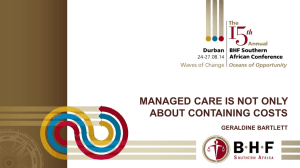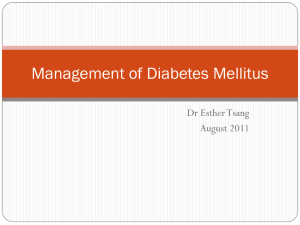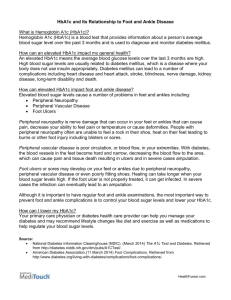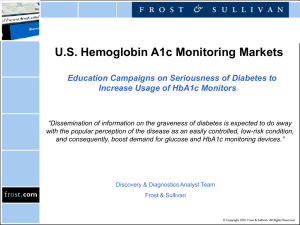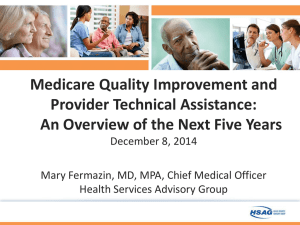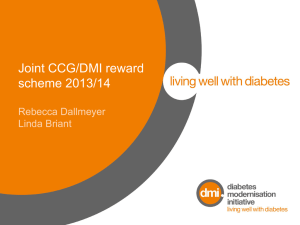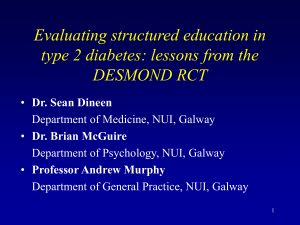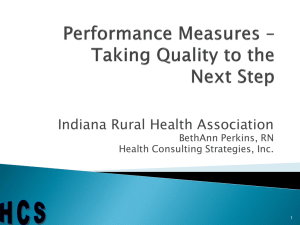Structured diabetes education has made little difference to patient
advertisement
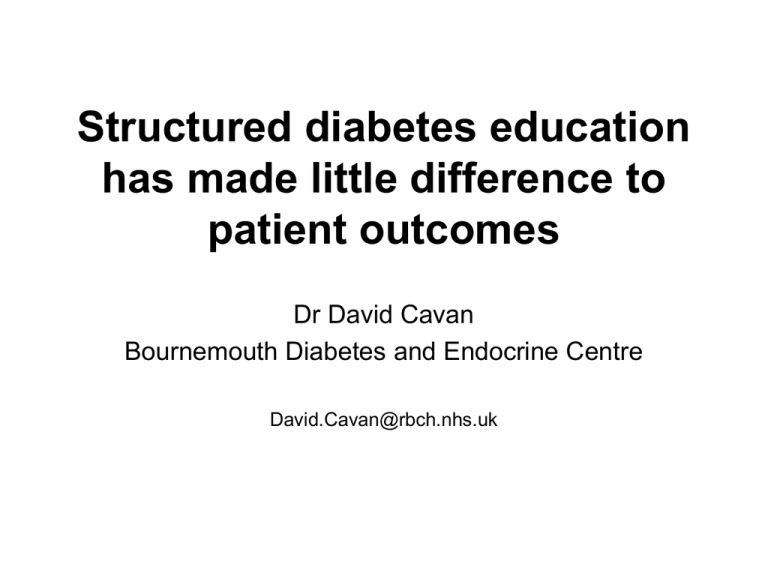
Structured diabetes education has made little difference to patient outcomes Dr David Cavan Bournemouth Diabetes and Endocrine Centre David.Cavan@rbch.nhs.uk 2001 2001 www.dh.gov.uk/en/Publicationsandstatistics/Publications/PublicationsPolicyAndGuidance/DH_4002951 2005 Structured education: Key Criteria to fulfil NICE requirements • • • • • Patient centred philosophy Structured, written curriculum Trained educators Quality assurance Audit NICE Diabetes Quality Standard 1: People with diabetes and/or their carers receive a structured education programme that fulfils the nationally agreed criteria from the time of diagnosis, with annual review and access to ongoing education Type 1 diabetes • 90+ centres run DAFNE (1 week course) – Based on Berger 5 day programme • 90+ centres run local programmes – majority using 4 x weekly format (eg BERTIE) – 20 using other formats (1 to 6 sessions) – Specific programmes for newly diagnosed and for pump therapy • paediatric / adolescent programmes Local vs national? Change from baseline to one year HbA1c Hypo DKA PAID • • National (DAFNE) ↓ ↓ 8.7 to 8.5% ↓ ↓ ↓ – Bournemouth 8.7 to 8.4% ↓ – – – – 8.9 to 8.7% 8.9 to 8.3% 8.7 to 8.4% 8.7 to 8.4% – Aberdeen – Nottingham – Ireland 8.6 to 8.5%(ns) 8.6 to 8.3% no change – National Local Wirral Edinburgh Eastbourne DEN 5 centres* Source: Diabetes UK and EASD abstracts 2010-2012 (*DEN 2008) ↓ ↓ ↓ ↓ 21 to 15 27 to 16 27 to 11 29 to 18 Type 1 programmes: outcomes • • • • Reduction in hypoglycaemia and DKA Improvement in PAID scores Weight neutral Reduction in HbA1c: 0-0.5% – Less than seen in Germany Type 2 diabetes • X-Pert • DESMOND • local programmes X-Pert • Six 2-hour weekly sessions • New and established type 2 diabetes • RCT: – HbA1c reduction 0.7% (no change in controls) – 0.5kg weight loss – Less medications • National audit >20,000 patients – – – – HbA1c reduction 0.5-0.7% Weight reduction 2-3kg 48% reduced diabetes medications Deakin, Diab Med 2012 29(1) 12 DESMOND RCT results • 6 hours (in 1 or 2 sessions) of group education within 12 weeks of diagnosis • Philosophy of patient empowerment • At one year: – – – – HbA1c reduced from 8.4 to 6.8% (NS vs control) Reduced body weight (3 vs 1.9 kg) Fewer smokers (14 to 11% vs no change) Reduced 10 year cardiovascular risk (10.9 vs 13.6%) • At three years: – No difference in any biomedical or lifestyle outcomes – Khunti BMJ 2012: 344:e2333 Type 2 education at diagnosis 9.5 9 Desmond control – 6 hours ‘ad hoc’ education 8.5 8 7.5 7 6.5 Focus – 5 hours ‘local’ education Desmond trial – 6 hours education 6 Baseline Focus 2004 3-4 months 1 year DESMOND trial 2 years DESMOND control 3 years UKPDS Type 2 education at diagnosis 9.5 UKPDS – 3 dietitian visits 9 Desmond control – 6 hours ‘ad hoc’ education 8.5 8 7.5 7 6.5 Focus – 5 hours ‘local’ education Desmond trial – 6 hours education 6 Baseline Focus 2004 3-4 months 1 year DESMOND trial 2 years DESMOND control 3 years UKPDS Summary of outcomes • Type 1 education – Reduction in hypoglycaemia and DKA – Improvement in PAID scores – Small reduction in HbA1c • Type 2 education – Reduction in HbA1c following diagnosis – As good as 3 dietitian visits in UKPDS Outcomes that matter Diabetes UK 2012: Between 2006 and 2010, there has been an increase in unnecessary complications: • • • • retinopathy stroke kidney failure amputations increased by 118% 87% 56% 26% Outcomes that matter National Diabetes Audit 2011 • Mortality 1.6 times higher (type 2) and 2.6 x higher (type1) than general population • 9 times higher in young women with type 1 diabetes Impact of structured education? National Diabetes Audit 2011 Attended structured education: • 1.55% newly diagnosed type 1 • 3.57% newly diagnosed type 2 Summary • Type 1 education has improved selfmanagement skills with important benefits to some patients – but HbA1c and hence risk of complications remains high • Type 2 education at diagnosis is no better than achieved in UKPDS • The provision and uptake of education is too small to make a difference at national level • Ongoing education is virtually non-existent Conclusion • Structured diabetes education has made little difference to patient outcomes

